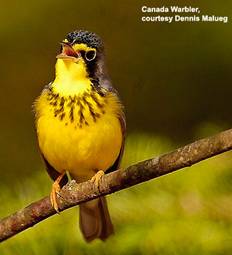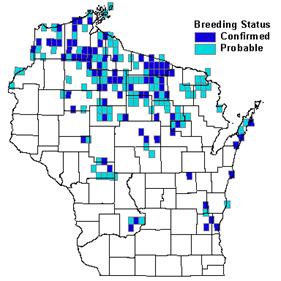Photo by Dennis Malueg


Status/Protection
- Global Rank: G5 Key to global and state ranks
- State Rank: S3B
- WBCI Priority: SGCN, PIF, State Special Concern
Population Information
Federal BBS information can be obtained at http://www.mbr-pwrc.usgs.gov/bbs/bbs.html by clicking on Trend Estimates and selecting the species in question. All estimates are for 1966-2005.
*Note: There are important deficiencies with these data. These results may be compromised by small sample size, low relative abundance on survey route, imprecise trends, and/or missing data. Caution should be used when evaluating this trend.
- Federal Breeding Bird Survey: significant decline
- Federal Breeding Bird Survey (WI): non-significant decline
- Federal Breeding Bird Survey (BCR 23): non-significant increase*
- Federal Breeding Bird Survey (BCR 12): non-significant decline
- Chequamegon National Forest Bird Survey (NRRI): non-significant increase (1992-2005)
- WSO Checklist Project: stable (1983-2007)
Life History
- Breeding Range: Eastern British Columbia east across southern Canada and the northeastern U.S. to Atlantic Coast, extending south into Appalachian Mountains (Conway 1999).
- Breeding Habitat: Swamp Conifer-Balsam Fir, Black Spruce, Fir-Spruce, Swamp Hardwood, Alder Thicket, White Cedar, mixed deciduous-coniferous forests.
- Nest: Cup, near or on ground (Conway 1999).
- Nesting Dates: Early June to early July (WSO 1995).
- Foraging: Hover and glean, foliage glean, ground glean (Ehrlich et al. 1988).
- Migrant Status: Neotropical migrant.
- Habitat use during Migration: Shrubs, vines, thickets, swamps, woodlands, floodplain forests, dense vegetation (Conway 1999).
- Arrival Dates: Early May to early June (Robbins 1991).
- Departure Dates: Early August to mid-September (Robbins 1991).
- Winter Range: Columbia, Venezuela, Brazil, Ecuador, Peru (DeGraaf and Rappole 1995).
- Winter Habitat: Coffee plantations, cloud forest and rain forest, forest edge (Conway 1999).
Habitat Selection
Canada Warblers are typically most abundant in moist, mixed coniferous-deciduous forests with a well-developed understory (Conway 1999). In Wisconsin they occur in spruce, hemlock, and balsam fir forest types in the northern counties (Robbins 1991). Important components of breeding habitat include conifers (Epstein 2006) and often creeks and streams (Hanowski and Niemi 1991). The Canada Warbler nests in dense vegetation, often in areas with mosses, ferns, and decaying stumps or logs. During migration this species often is found in both dry and humid forests, swamps, and forest edge, usually below 2,500 meters in elevation in Mexico, and below 1,500 meters elevation in Honduras. On the wintering grounds in Peru and Ecuador, Canada Warblers are present on Andean slopes and lowlands, usually in dense vegetation (Conway 1999).
Habitat Availability
Bog and swamp community types cover ~340,000 hectares in northern Wisconsin and aspen-birch associations cover an even larger area (Hoffman and Mossman 1993). However, many of these areas support low densities of Canada Warbler. In the Upper Midwest certain habitats that might normally harbor this species are often severely over-browsed by deer and do not provide the well-developed shrub and sapling strata needed by Canada Warbler (Epstein 2006).
Population Concerns
Breeding Bird Survey data suggest significant population declines continent-wide for this species and non-significant declines in Wisconsin (Sauer et al. 2005). During the six-year period (1995-2000) of the Wisconsin Breeding Bird Atlas, observers confirmed breeding in 7% of the surveyed quads (Epstein 2006). Loss and fragmentation of northern forests through residential development, road building, and habitat-conversion negatively impacts this species (WDNR 2005). Forest management practices that reduce understory density are not suitable for this species (Conway 1999). Deforestation of mid-elevational tropical forests on the east slope of the Andes Mountains where this species winters also may significantly contribute to its long-term decline (WDNR 2005).
Recommended Management
Management efforts for Canada Warbler should focus on maintaining structurally-complex understories within large forest blocks. This may require reducing deer densities in conservation areas designated for this species (WDNR 2005). This species will respond favorably to timber harvesting provided a well-developed shrub layer is present (Hobson and Schieck 1999). Addressing habitat loss on the wintering grounds should be a high priority since it is unclear if this is the primary factor limiting Canada Warbler populations (Robinson 1997).
Conservation and management strategies for this species should be focused in the following Wisconsin ecological landscapes: Central Lake Michigan Coastal, Forest Transition, North Central Forest, Northeast Sands, Northern Highland, Northern Lake Michigan Coastal, Northwest Lowlands, and Superior Coastal Plain (WDNR 2005). Within these landscapes, good examples of Canada Warbler habitat can be found at the Upper Brule River in Douglas County, Miscauno Cedar Swamp in Marinette County, and St. Croix Ash Swamp in Burnett County (Hoffman and Mossman 1993), and along the Namakagon River in Washburn County.
Research Needs
Causes of this species’ decline need to be addressed. Studies that investigate the impacts of habitat alteration and degradation on the wintering grounds are urgently needed. Further information is needed on the Canada Warbler’s degree of area-sensitivity and susceptibility to Brown-headed Cowbird parasitism (Conway 1999). More studies investigating the impacts of forest management practices on this species are warranted.
Information Sources
- Chequamegon National Forest Bird Survey (NRRI) species account: http://www.nrri.umn.edu/mnbirds/accounts/CAWAa2.htm
- Nicolet National Forest Bird Survey Map: http://www.uwgb.edu/birds/nnf/species/CAWA.htm
- North American Breeding Bird Survey: http://www.mbr-pwrc.usgs.gov/bbs/bbs.html
- Western Great Lakes Bird Conservation probability map: http://www.uwgb.edu/birds/greatlakes/species/cawamap2.htm
- Temple S.A., J.R. Cary, and R. Rolley. 1997. Wisconsin Birds: A Seasonal and Geographical Guide. Wisconsin Society of Ornithology and Wisconsin Department of Natural Resources, Madison, WI.
- Wisconsin Breeding Bird Atlas: http://www.uwgb.edu/birds/wbba/
References
- Conway, C.J. 1999. Canada Warbler (Wilsonia canadensis), In The Birds of North America, No. 421, Cornell Laboratory of Ornithology, Ithaca, NY, and The American Ornithologists’ Union, Washington, D.C.
- DeGraaf, R.M. and J.H. Rappole. 1995. Neotropical migratory birds: natural history, distribution, and population change. Comstock Publ. Assoc., Cornell Univ. Press, Ithaca, NY.
- Ehrlich, P.R., D.S. Dobkin, and D. Wheye. 1988. The birders handbook: a field guide to the natural history of North American birds. Simon & Schuster, Inc. New York.
- Epstein, E. 2006. Canada Warbler. In Atlas of the Breeding Birds of Wisconsin. (N.J. Cutright, B.R. Harriman, and R.W. Howe, eds.) The Wisconsin Society for Ornithology, Inc. 602pp.
- Hanowski, J.M. and G.J. Niemi. 1991. Monitoring bird populations on National Forest lands: Superior National Forest, 1991. SNF Report no.1, NRRI/TR-91/21. Duluth, MN: Center for Water and the Environment, Natural Resources Research Institute, Univ. of Minnesota.
- Hobson, K.A. and J. Schieck. 1999. Changes in songbird communities in boreal mixedwood forest: harvest and wildfire effects over 30 years. Condor 9(3):849-863.
- Hoffman, R.M. and M.J. Mossman. 1993. Birds of Wisconsin’s northern swamps and bogs. Pass. Pigeon 55(2): 113-138.
- Rappole, J.H. 1995. The ecology of migrant birds. Smithsonian Institution Press, Washington, D.C.
- Robbins, S. D. 1991. Wisconsin birdlife: population & distribution, past & present. Univ. of Wisconsin Press, Madison, WI.
- Robinson, S.K. 1997. Review of Nearctic Passerine Migrants in South America, by Raymond A. Paynter, Jr. Wilson Bull. 109: 555-556.
- Sauer, J.R., J.E. Hines, and J. Fallon. 2005. The North American Breeding Bird Survey, Results and Analysis 1966 - 2005. Version 6.2.2006. USGS Patuxent Wildlife ResearchCenter, Laurel, MD.
- Wisconsin Department of Natural Resources (WDNR). 2005. Wisconsin’s Strategy for Wildlife Species of Greatest Conservation Need. Madison, WI.
- Wisconsin Society for Ornithology (WSO). 1995. Wisconsin breeding bird atlas; atlasing handbook 1995-1999. Wisconsin Society for Ornithology, Inc., Hartland, WI.
Contact Information
- Compiler: William P. Mueller, iltlawas@earthlink.net
- Editors: Kim Kreitinger, K.Kreitinger@gmail.com |
Jon Robaidek, Jon.Robaidek@Wisconsin.gov
